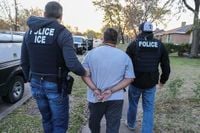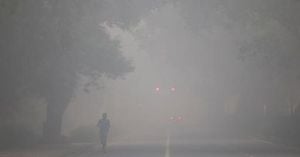Texas, a state long known for its economic dynamism and rapid job creation, is now grappling with a slowdown that experts and business leaders attribute largely to a federal immigration crackdown. According to new data released on October 22, 2025, by the Federal Reserve Bank of Dallas, the state’s job growth this year has fallen to just 1.2%—the lowest rate since the onset of the COVID-19 pandemic in 2020. This figure is not only well below Texas’s long-run trend of about 2%, but also marks the first time since at least 2018 that the state has slipped beneath that benchmark.
The culprit, economists say, is not a mystery. The Dallas Fed’s latest Texas Business Outlook Surveys point directly to recent shifts in federal immigration policy, which have intensified enforcement and led to a chilling effect across the state’s labor market. One in five Texas businesses now reports difficulty hiring and retaining foreign-born workers, a demographic critical to the state’s workforce. In fact, 13% of businesses surveyed cited a "negative impact" from the federal crackdown in 2025, as reported by both Texas Public Radio and the San Antonio Current.
“They’re afraid to go shopping. They’re afraid to take their kids to school. They’re afraid to go to church, and perhaps most importantly right now, they are afraid to go to work,” said Madeline Zavodny, an economics professor at the University of North Florida and co-author of the Dallas Fed report, as quoted by Texas Public Radio. Zavodny’s comments capture the anxiety that has spread through migrant communities, particularly among those without legal status. This pervasive fear has led to a significant uptick in absenteeism among foreign-born employees; the survey found that 40% of businesses reported their migrant workers missed work because of concerns about immigration enforcement.
Employers are feeling the pinch. Many worry about losing a trained workforce that is not easily replaced. Zavodny explained, “They’re very worried about how many foreign-born workers are staying home and even just leaving. Either leaving the state or even leaving the country.” This exodus—or even the mere threat of it—has forced businesses to scramble for replacements, often with little success.
The impact is not limited to the labor supply. The Dallas Fed report notes that fear in immigrant communities has also reduced sales and customer counts for some businesses. One retailer told surveyors, “[We have experienced] reduced sales to foreign-born customers, and customer counts [have been] down periodically due to raids by ICE in the area.” These comments underscore how the effects of enforcement ripple outward, touching not only workers but also the broader consumer economy.
What’s particularly striking is that the Dallas Fed survey does not even capture the full extent of the problem. According to the San Antonio Current, the survey excludes some of the sectors most dependent on immigrant labor, such as construction and agriculture. This omission suggests that the true scale of the negative impact may be significantly underrepresented in the official numbers.
Texas’s struggles are not occurring in a vacuum. The Dallas Fed notes that since immigration enforcement changes began in mid-2024, both U.S. and Texas job growth have fallen well below their respective long-run trends. The report states, “Given the decline in immigration inflows, increase in arrests and removals of immigrants already here and the chilling effect, labor supply is clearly being affected.”
The demographic context only deepens the challenge. The surveys indicate that the “U.S. born workforce cannot make up for reduced immigration due to demographic pressures, including an aging population and low birth rates.” In other words, even if every U.S.-born worker were mobilized, it would not be enough to fill the gap left by declining immigration. Texas, like much of the Sun Belt, has historically benefited from a steady influx of migrants, who contribute not only to the labor force but also to population growth and, by extension, economic expansion.
Some hope that technology could help bridge the gap. Automation, artificial intelligence, and mechanization are often touted as potential solutions for labor shortages. The Dallas Fed acknowledges that these tools could offset some of the issues caused by a declining labor supply. However, the report cautions that neither automation nor AI can fully compensate for the loss of immigrant labor—at least not anytime soon. The survey’s authors write, “While employers could offset some of the labor problems with automation and AI, the Dallas Fed cautions that neither can completely make up the difference.”
Looking ahead, the demographic trends are stark. By 2031, all growth in the U.S. population is expected to come from immigration, according to the Dallas Fed. The implication is clear: immigration policy will increasingly set the "speed limit for the economy." If current restrictions persist, the state—and the nation—could face persistent headwinds to growth.
This forecast is especially sobering for Texas, a state that has long prided itself on outpacing the rest of the country in job creation and economic vitality. The Dallas Fed’s findings suggest that without a change in federal policy, the era of rapid Texas growth may be drawing to a close. Zavodny, the economist, said she expects the slower job growth in Texas to continue as long as the same federal immigration policies are in place.
Some analysts point out that Sun Belt states like Texas might offset some of the migrant population loss by attracting U.S. citizens from other states. However, the surveys suggest that this internal migration is unlikely to fully substitute for the economic and demographic contributions of immigrants. The aging U.S. population and ongoing low birth rates mean that the labor force is shrinking, and without immigration, there simply aren’t enough new workers to keep up with demand.
For businesses, the situation is already pressing. Many are struggling to maintain operations with fewer workers, and some have had to cut back hours or reduce services. Others are investing in new technology to try to fill the gap, but the transition is neither easy nor immediate. As one business owner put it, “We’re doing what we can, but you can’t replace experience and dedication overnight.”
Meanwhile, the human cost of the crackdown is evident in communities across Texas. Families are living in fear, workers are staying home, and business owners are facing tough choices. The economic data tells a story of slowdown, but behind the numbers are real people—employees, customers, and entrepreneurs—caught in the crosscurrents of policy and politics.
As 2031 approaches, the link between immigration and economic growth is only expected to tighten. For Texas and the nation, the choices made on immigration policy today will shape the economic landscape for years to come.




